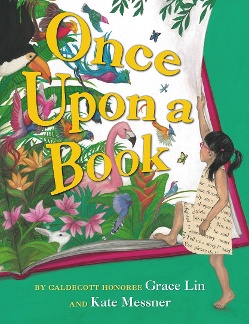Brian Wilson contends that Once upon a Book, written by Kate Messner and illustrated by Grace Lin, "truly honors the Caldecott terms and criteria by providing the child a 'visual experience' and respecting children’s 'understandings, abilities, and appreciations.'”
For the past several years, I have run a mock Caldecott program for first to eighth graders at my public library. For each contending book, I lead the children through an “art walk” during which we talk about the images and how they tell the story. This leads to some intriguing conversations, with the observant students noticing things that we adults have not.
During a recent meeting, I presented Once upon a Book, illustrated by 2019 Caldecott honoree and 2022 Children’s Literature Legacy Award winner, Grace Lin. In this meta tale about a bored girl named Alice who finds both comfort and danger after she enters a book’s extraordinary world, Lin packs the pages with images that had the young art enthusiasts in my library shouting out what caught their attention. The children became excited when they saw Alice’s dress change from scene to scene, and when the white rabbit appears in different incarnations. Once upon a Book truly honors the Caldecott terms and criteria by providing the child a “visual experience” and respecting children’s “understandings, abilities, and appreciations.”
Although I am stressing the impact of the book's art in this post, I am by no means discounting the beautiful text co-written by Lin and Kate Messner. They have written a book that begs to be read aloud. The words match the playfulness of Lin’s witty and beautiful gouache paintings as Alice travels from world to world.
 Lin sets up Alice’s situation even before the title page. In a vivid double-page spread, she starts by placing the reader outside of Alice’s house. We see the girl unhappily looking out the window on a rainy and cold gray day. A day so miserable even the snow person that Alice built melts with weary defeat. In an effective juxtaposition, Alice’s cat peers out another window, but with a content, happy expression. A sign on the front door has Chinese characters written on it and adds a soothing warmth. There is an evocative mix of tone and mood here.
Lin sets up Alice’s situation even before the title page. In a vivid double-page spread, she starts by placing the reader outside of Alice’s house. We see the girl unhappily looking out the window on a rainy and cold gray day. A day so miserable even the snow person that Alice built melts with weary defeat. In an effective juxtaposition, Alice’s cat peers out another window, but with a content, happy expression. A sign on the front door has Chinese characters written on it and adds a soothing warmth. There is an evocative mix of tone and mood here.
The title page then shows Alice rummaging through her dresser, finding a rather surreal dress covered with words. Those going through the book on a repeat visit (this story invites revisits) will notice that the objects near Alice represent images that later appear. Bunny slippers. A camel figurine. A moon-shaped lamp with a sleeping rabbit (as mentioned, rabbits play a big role in this story, perfect for the Year of the Rabbit).
A flip of the page takes the reader into the main action. Donning the word-covered dress, Alice unhappily stomps through a room where her mom works on a laptop. Lin excels at depicting Alice’s rather dramatic body language. And now the reader and Alice see a book, tiny on the spread’s otherwise blank right page. Just as a white rabbit played a crucial role in Alice in Wonderland, a cute bunny lures Alice into this mini-book. Suddenly Once upon a Book takes on a meta self-referential feel, with the same words—“Curious, Alice began to read”—appearing in both books, the one the reader is reading and the one that Alice discovers.
For Once upon a Book to completely work, Lin needs to pull off the next key moments. And she does beautifully. Lin shows Alice crouched over the book, which has a painting of exotic birds featured. The reader also assumes Alice’s point of view while she holds the book, her hands on either side, about to turn a page. In other words, she is looking at herself holding the book (and the reader becomes Alice). Meanwhile, the birds burst out of the frame, inviting her to join them in their tropical world. A smaller Alice now steps into the book, which has become massive.
Next, our heroine sits in a tree, surrounded by her new feathered friends. Readers will notice that Alice’s dress has changed. It’s now as green as the leaves. And also, the birds (and bunny) that at first looked cartoon-like are now more realistically rendered. Lin really flexes her artistic muscles throughout, changing up her style, doing something new. She uses the book’s large dimensions to great effect, creating a series of thrilling cinematic moments.
The book then follows a satisfying narrative pattern. Alice enjoys her new surroundings at first but then something goes awry. New characters pop up in the book and suggest they join her in a new radically different locale. So when rain disrupts her tranquil stay in the tree, camels suggest visiting them in the dry desert. Her dress changes to the color of sand. In the desert, a sandstorm erupts, so she joins fish in the ocean. And so on. Soon she soars with the clouds in the sky, and then, in a moment that will have some readers thinking of her 2019 Caldecott Honor book, A Big Mooncake for Little Star, floating in space. Kids love noticing that the rabbit swims, soars, and floats along with Alice.
Lin does a great job with color throughout. The birds’ feathers, the coral, and those lovely tropical fish all pop off the page. That soothing blue sky. Those glittering yellow stars. But danger abounds. The sky turns stormy. Seaweed entangles. And Alice feels lonely in the cosmos. At a major crisis point, Alice is falling, falling, falling through the book back into her family’s comforting house. In a lovely touch, Alice’s mom and dad appear in the book Alice possesses. They, of course, are an essential part of her story.
Visually, Lin takes us full circle at the end. She once again places the reader outside of Alice’s house. Through one window, Alice can be seen reading the book to her parents while they eat dinner. The cat sleeps in the other window. Meanwhile, the moon shines in the sky. The children will happily shout out that they can see the rabbit in the moon. Smiling happily.
[Read The Horn Book Magazine review of Once upon a Book]

ALREADY A SUBSCRIBER? LOG IN
We are currently offering this content for free. Sign up now to activate your personal profile, where you can save articles for future viewing.








Add Comment :-
Comment Policy:
Comment should not be empty !!!
Sam Juliano
"Lin does a great job with color throughout. The birds’ feathers, the coral, and those lovely tropical fish all pop off the page. That soothing blue sky. Those glittering yellow stars. But danger abounds. The sky turns stormy. Seaweed entangles. And Alice feels lonely in the cosmos. At a major crisis point, Alice is falling, falling, falling through the book back into her family’s comforting house. In a lovely touch, Alice’s mom and dad appear in the book Alice possesses. They, of course, are an essential part of her story."An absolutely fabulous essay by the esteemed Chicago-area librarian Brian Wilson. In looking through this year's children's books and the large order that arrived weeks ago at my school, my wife and I immediately counted this as one of the year's most beautiful and audacious works. Much like Buster Keaton, who famously entered the frame in "Sherlock Jr.," the deceit is this book is magnificently realized, at no expense to the beauty of the art. The above paragraph from Mr. Wilson is just some of his own masterfully descriptive analysis for a children's book that fully warrants it.Posted : Nov 22, 2023 07:34